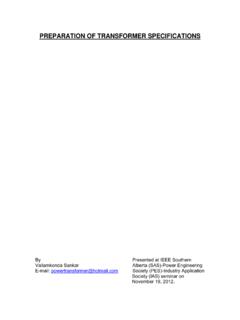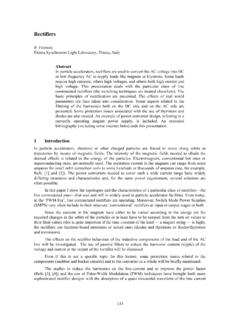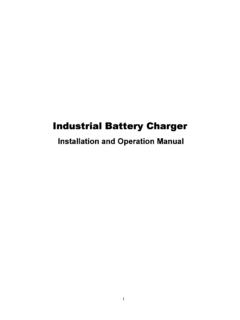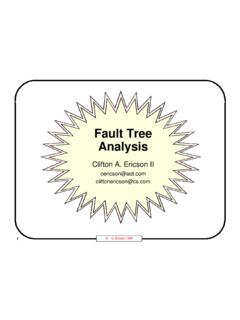Transcription of Training data-efficient image transformers & distillation ...
1 Training data-efficient image transformers & distillation through attentionHugo Touvron?, Matthieu Cord Matthijs Douze?Francisco Massa?Alexandre Sablayrolles?Herv e J egou??Facebook AI Sorbonne UniversityAbstractRecently, neural networks purely based on attention were shown to ad-dress image understanding tasks such as image classification. These high-performing vision transformers are pre-trained with hundreds of millionsof images using a large infrastructure, thereby limiting their this work, we produce competitive convolution-free transformers bytraining on Imagenet only.
2 We train them on a single computer in less than3 days. Our reference vision transformer (86M parameters) achieves top-1accuracy of ( single -crop) on ImageNet with no external importantly, we introduce a teacher-student strategy specific totransformers. It relies on a distillation token ensuring that the studentlearns from the teacher through attention. We show the interest of thistoken-based distillation , especially when using a convnet as a teacher. Thisleads us to report results competitive with convnets for both Imagenet(where we obtain up to accuracy) and when transferring to othertasks.
3 We share our code and IntroductionConvolutional neural networks have been the main design paradigm for imageunderstanding tasks, as initially demonstrated on image classification of the ingredient to their success was the availability of a large Training set,namely Imagenet [13, 42]. Motivated by the success of attention-based mod-els in Natural Language Processing [14, 52], there has been increasing interestin architectures leveraging attention mechanisms within convnets [2, 34, 61].More recently several researchers have proposed hybrid architecture trans-planting transformer ingredients to convnets to solve vision tasks [6, 43].
4 The vision transformer (ViT) introduced by Dosovitskiy et al. [15] is an ar-chitecture directly inherited from Natural Language Processing [52], but ap-1 [ ] 15 Jan 2021 Figure 1: Throughput and accuracy on Imagenet of our methods compared toEfficientNets, trained on Imagenet1k only. The throughput is measured as thenumber of images processed per second on a V100 GPU. DeiT-B is identical toVIT-B, but the Training is more adapted to a data-starving regime. It is learnedin a few days on one machine. The symbol refers to models trained with ourtransformer-specific distillation .
5 See Table 5 for details and more to image classification with raw image patches as input. Their paper pre-sented excellent results with transformers trained with a large private labelledimage dataset (JFT-300M [46], 300 millions images). The paper concluded thattransformers do not generalize well when trained on insufficient amounts of data ,and the Training of these models involved extensive computing this paper, we train a vision transformer on a single 8-GPU node in twoto three days (53 hours of pre- Training , and optionally 20 hours of fine-tuning)that is competitive with convnets having a similar number of parameters andefficiency.
6 It uses Imagenet as the sole Training set. We build upon the vi-sual transformer architecture from Dosovitskiy et al. [15] and improvementsincluded in the timm library [55]. With our Data-efficient image transformers (DeiT), we report large improvements over previous results, see Figure 1. Ourablation study details the hyper-parameters and key ingredients for a success-ful Training , such as repeated address another question: how to distill these models? We introducea token-based strategy, specific to transformers and denoted by DeiT , andshow that it advantageously replaces the usual summary, our work makes the following contributions: We show that our neural networks that contains no convolutional layercan achieve competitive results against the state of the art on ImageNetwith no external data.
7 They are learned on a single node with 4 GPUs inthree days1. Our two new models DeiT-S and DeiT-Ti have fewer param-eters and can be seen as the counterpart of ResNet-50 and ResNet-18. We introduce a new distillation procedure based on a distillation token,which plays the same role as the class token, except that it aims at re-producing the label estimated by the teacher. Both tokens interact in thetransformer through attention. This transformer-specific strategy outper-forms vanilla distillation by a significant margin. Interestingly, with our distillation , image transformers learn more from aconvnet than from another transformer with comparable performance.
8 Our models pre-learned on Imagenet are competitive when transferred todifferent downstream tasks such as fine-grained classification, on severalpopular public benchmarks: CIFAR-10, CIFAR-100, Oxford-102 flowers,Stanford Cars and iNaturalist-18 paper is organized as follows: we review related works in Section 2,and focus on transformers for image classification in Section 3. We introduceour distillation strategy for transformers in Section 4. The experimental sec-tion 5 provides analysis and comparisons against both convnets and recenttransformers, as well as a comparative evaluation of our transformer-specificdistillation.
9 Section 6 details our Training scheme. It includes an extensive ab-lation of our data-efficient Training choices, which gives some insight on thekey ingredients involved in DeiT. We conclude in Section Related workImage Classificationis so core to computer vision that it is often used as abenchmark to measure progress in image understanding. Any progress usu-ally translates to improvement in other related tasks such as detection or seg-mentation. Since 2012 s AlexNet [32], convnets have dominated this bench-mark and have become the de facto standard. The evolution of the state of theart on the ImageNet dataset [42] reflects the progress with convolutional neuralnetwork architectures and learning [32, 44, 48, 50, 51, 57].
10 Despite several attempts to use transformers for image classification [7], un-til now their performance has been inferior to that of convnets. Neverthelesshybrid architectures that combine convnets and transformers , including theself-attention mechanism, have recently exhibited competitive results in imageclassification [56], detection [6, 28], video processing [45, 53], unsupervised ob-ject discovery [35], and unified text-vision tasks [8, 33, 37].1We can accelerate the learning of the larger model DeiT-B by Training it on 8 GPUs in two Vision transformers (ViT) [15] closed the gap with the state of theart on ImageNet, without using any convolution.
![arXiv:0706.3639v1 [cs.AI] 25 Jun 2007](/cache/preview/4/1/3/9/3/1/4/b/thumb-4139314b93ef86b7b4c2d05ebcc88e46.jpg)

![arXiv:1301.3781v3 [cs.CL] 7 Sep 2013](/cache/preview/4/d/5/0/4/3/4/0/thumb-4d504340120163c0bdf3f4678d8d217f.jpg)
![@google.com arXiv:1609.03499v2 [cs.SD] 19 Sep 2016](/cache/preview/c/3/4/9/4/6/9/b/thumb-c349469b499107d21e221f2ac908f8b2.jpg)











